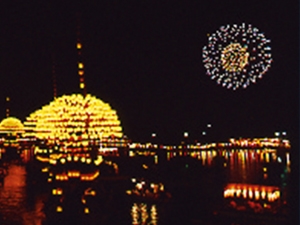- HOME
- Search in the site
- Tsushima Shrine

Tsushima Shrine, known for its Owari Tsushima Tenno Festival, is the spiritual home of Gozutenno, the deity of pestilences and blessings, and used to be called "Tsushima Gozutenno-sha." The Tsushima Shrine dates back more than 1,450 years, and is said to have been first erected in the first year of Emperor Kinmei in 540 A.D. The enshrined deity is named Takehayasusa no Onomikoto, and he shares the shrine with his child, Onamuchi no Mikoto. Being the head of more than 3,000 Tsushima Shrines nationwide, this shrine is worshiped by people as a "Tenno Shrine," and is held in the same esteem as Yasaka Shrine in Kyoto.

The spiritual powers of the deities enshrined in Tsushima Gozutenno-sha empower the people, and were venerated by the feudal warlords and daimyo lords, especially Oda, Toyotomi, and Tokugawa. Oda Nobunaga honored the Tsushima Shrine as the tutelary shrine and made donations and cooperated in its construction. The sakura-gate and south gate (prefectural cultural property) were donated by Toyotomi Hideyoshi, and the main shrine is said to have been donated by Tokugawa Ieyasu's fourth son and lord of Kiyosu Castle, Matsudaira Tadayoshi. Reverently worshiped since ancient times, it was once common practice to visit Tsushima Shrine when visiting Ise-jingu Shrine and people used to say that "if you're going to Oise-san, you must go to the Tsushima-san as well or else you only get half the job done." The Tsushima Shrine is still known by the name "Tsushima-san" or "Tenno-san" and is visited by people from all over the country.

The biggest festival of Tsushima Shrine, the Owari Tsushima Tenno Festival, a summer tradition and one of the greatest river festivals of Japan, takes place on the fourth Saturday of July. Five Tsushima makiwara boats are lit, and they elegantly make their way across the Tenno River (Maruike Pond) surrounded by the music of Tsushima flutes. The swaying lanterns reflected on the water enhance the beauty of the makiwara boats, and the fantastical illusion of light and water is just like a scene depicted on a picture scroll of old. In the Morning Festival, the boats led by the sixth "ichieguruma" change their attire to Noh stage and advance as the music plays. From the leading ichieguruma, ten heroic men dive into the water holding pikes covered with cloths, swim across, and run up to the shrine to offer the pikes.
| Location | : 〒496-0851 1, Shinmei-cho, Tsushima-City, Aichi |
|---|---|
| Fee | : Free |
| Opening days / hours |
: None |
| Parking | : South: 60 parking spaces (buses can park) East: 40 parking spaces (micro buses can park) Temporary parking available during New Year's and Owari Tsushima Tenno Festival, etc. * Use the east parking to receive prayers for safe journeys (use the south parking from January 2 to 7). |
|---|---|
| Holidays | : Open everyday |
| Phone number | : 0567-26-3216 |
Note: This page may not be current due to update time differences between site databases.
Should accuracy be critical, please verify this information using a direct source, whenever possible.
Barrier-free information
LINK
ACCESS
-

- Access by public transport
- From Nagoya Station, take the Meitestu Tsushima Line.
Alight at Tsushima Station and 15 minutes walk.
-

- Access by car
- 15 minutes from Higashimeihan Expressway Higashimeihanyatomi I.C
15 minutes from hinomiyakisogawa I.C
Share spot information with a smartphone

ACCESS MAP
 Keyword
Keyword- #Tsushima Shrine
INFORMATION ON THE SURROUNDING AREA
- Birthplace of Oda Nobunaga / Shobata Castle Site
- According to the ancient manuscript, "Records of Owari Castles," defining the birth sites ...
- Roadside Station "Michi-no-Eki" Tatsuta Fureai-no-Sato
- The city of Aisai is famous for its expansive farms of renkon - lotus root - which are ble...
- Tomiyoshi Tatehaya Jinja Shrine and Hakkensha Shrine
- Located on the east bank of the Kanie River, the enshrined deity at Tomiyoshi Tatehaya Jin...
- Kiyosu Castle
- Kiyosu Castle was the starting point of local feudal lord and hero Oda Nobunaga on his cam...
- Nagoya City Hideyoshi & Kiyomasa Memorial Museum
- A history museum on the 2nd floor of Nakamura Park Cultural Plaza. The museum mainly colle...


































